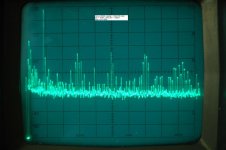Bernhard said:...referenced to -60dB 1kHz signal.
Bernhard said:
So I call the K2 disappointing.
Bernhard, have you really tested the DACs with 1kHz test tone?
On all the pictures presented in your old post?
Please, answer my question as it is really important

beauty_divine said:
Bernhard, have you really tested the DACs with 1kHz test tone?
On all the pictures presented in your old post?
Please, answer my question as it is really important
Yes, really. Why ?
Please also note that the plain K chip in post 15 in other thread is better than both K2.
From other thread:
beauty_divine said:
Hi Bernhard, I was wondering about the measurement setup.
Do you test the standalone DUT (DAC) or you play pre-recorded 1kHz -60dB test signal and test the entire signal path from optical pick up to the RCA output connectors of the player?
This would be critical for the way your mesurement results and conclusions should be understood.
Don't worry.
I tried the same chips, mostly PCM56 in different players with different lasers and different chipsets for servo and oversampling, differences were small, about 2 dB better with 8x os compared to 4x os.
Higher os rate is better for low level but worse for jitter and preringing.
On the other hand, different chips show very big differences in the same player, test setups can be regarded as neglible.
Bernhard,
Any possibility to show the photos of the chips under measurement?
I did not got througth all your old thread but are all the chips using the same IV converter to input the signal into the analyzer?
I may also want to measure my chips but I do not know what IV standard I should use!
Any possibility to show the photos of the chips under measurement?
I did not got througth all your old thread but are all the chips using the same IV converter to input the signal into the analyzer?
I may also want to measure my chips but I do not know what IV standard I should use!
Then try and measure with exactly 991Hz, and mention what BB state in the test spec for SDR and SNR - test tone 991Hz !
Then you'd must probably drastically change your oppinion, as I did, shifting from 1kHz to 991Hz and won't stay disappointed
I started a thread about this recently: http://www.diyaudio.com/forums/showthread.php?s=&postid=1374129#post1374129
As I used to work as a mixed-signal test engineer in a microelectronics company, I had as a rule on hand when a DUT did not meet the test spec I first suspected test problems i.e. myself doing irrelevant things, and then a DUT failure.
To my opinion it is unbelievable BB to pass failures like your test results showed. tested at 1kHz really fills in the spectrum with lots of trash
63 K grades really meet the spec - I bet the other DACs listed in your post too - if tested in a correct way.
Then you'd must probably drastically change your oppinion, as I did, shifting from 1kHz to 991Hz and won't stay disappointed
I started a thread about this recently: http://www.diyaudio.com/forums/showthread.php?s=&postid=1374129#post1374129
As I used to work as a mixed-signal test engineer in a microelectronics company, I had as a rule on hand when a DUT did not meet the test spec I first suspected test problems i.e. myself doing irrelevant things, and then a DUT failure.
To my opinion it is unbelievable BB to pass failures like your test results showed. tested at 1kHz really fills in the spectrum with lots of trash

63 K grades really meet the spec - I bet the other DACs listed in your post too - if tested in a correct way.
beauty_divine said:Then try and measure with exactly 991Hz, and mention what BB state in the test spec for SDR and SNR - test tone 991Hz !
Then you'd must probably drastically change your oppinion, as I did, shifting from 1kHz to 991Hz and won't stay disappointed
I started a thread about this recently: http://www.diyaudio.com/forums/showthread.php?s=&postid=1374129#post1374129
As I used to work as a mixed-signal test engineer in a microelectronics company, I had as a rule on hand when a DUT did not meet the test spec I first suspected test problems i.e. myself doing irrelevant things, and then a DUT failure.
To my opinion it is unbelievable BB to pass failures like your test results showed. Now I know the cause for your results
63 K grades really meet the spec - I bet the other DACs listed in your post too - if tested in a correct way.
Please not that old story !
I remember your 1 kHz problems. I never had them.
My 0 dB FFTs are clean to the noise floor and very good DACs on low level also.
FFT lenght is usually 2048 or 4096 points . I can adjust in steps of one, up to 16000 or 32000, don't remember, but never use more than 4096 because it slows down the measurement when doing MSB adjust and having averaging.
If it was a problem with my FFT, I would not have chips that are clean below (!) the noise floor ( 16 x average ) on - 60 dB signals.
Sorry, the PCM63 in general is not the very best chip.
PCM56 with MSB adjust beats it very easy.
spencer said:Bernhard,
Any possibility to show the photos of the chips under measurement?
I did not got througth all your old thread but are all the chips using the same IV converter to input the signal into the analyzer?
I may also want to measure my chips but I do not know what IV standard I should use!
What do you expect to see ?
A CD Player, preamp, Analyzer and some cables...
Usually all CD have very standard op amp I/V. Makes not much difference.
Bernhard, if you really want to check what BB claim their DACs meet, you must test them in a correct way - the same test setup and conditions and then to compare to the spec. Otherwise you may not complain or be disappointed.
What is common for all your tests, that represent mainly bad results, is the "wrong" test tone freq. May be if you put an effort and shift to what BB had found as a right test freq., you'd see some relevant results, far from what you've got on your photos.
I really could not find what really stays behind this odd 991Hz test tone freq., but obviously it worked out very good test results for me.
What is common for all your tests, that represent mainly bad results, is the "wrong" test tone freq. May be if you put an effort and shift to what BB had found as a right test freq., you'd see some relevant results, far from what you've got on your photos.
I really could not find what really stays behind this odd 991Hz test tone freq., but obviously it worked out very good test results for me.
stoolpigeon said:Bernhard, are you finding any correlation between measurements and sound quality?
cheers, sp
Yes, a very clean chip sounds clean, it lets you hear pure signals at low volume passages, pure means you can hear sounds that have not much overtones, alone or together with 'rich' sounds with lots of harmonics of other instruments or voices at the same time. There is maximum contrast between the pure / dark sounds and the rich / bright sounds.
Poor DACs sound like amplifiers with crossover distortion. At low levels everything is smeared with harmonics, there is no contrast, it may sound nice and enhanced 'rich' but all the same.
beauty_divine said:Bernhard, if you really want to check what BB claim their DACs meet, you must test them in a correct way - the same test setup and conditions and then to compare to the spec. Otherwise you may not complain or be disappointed.
What is common for all your tests, that represent mainly bad results, is the "wrong" test tone freq. May be if you put an effort and shift to what BB had found as a right test freq., you'd see some relevant results, far from what you've got on your photos.
I really could not find what really stays behind this odd 991Hz test tone freq., but obviously it worked out very good test results for me.
So what does BB claim for -60dB in their data sheets ?
They claim -48 dB and - 44 dB worst case for K grade.
What does my FFT show ?
Worst harmonics -52 to -55 dB for K2 chip and -60,5 dB for plain K chip.
This can not be compared directly because I refer to single harmonics and BB to THD but my measurements do not show results that are worse than what BB claims and I did not say BBs claim is false.
But other chips like good PCM56 show -65dB or nothing at all, so all my 'disappointment' is about that the super 20 bit colinear chip is beaten by an 'only' 16bit chip with MSB adjust which works in my non os DAC for may full satisfaction
Same analyzer setup, same test-CD, same player, same preamp, same everything, except DAC chips:
K:
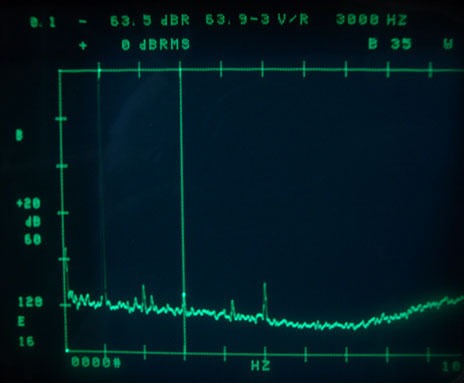
K2:
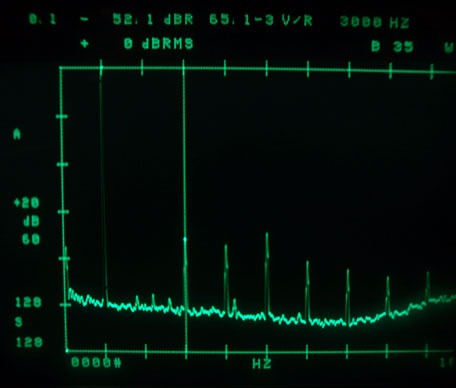
other K2:
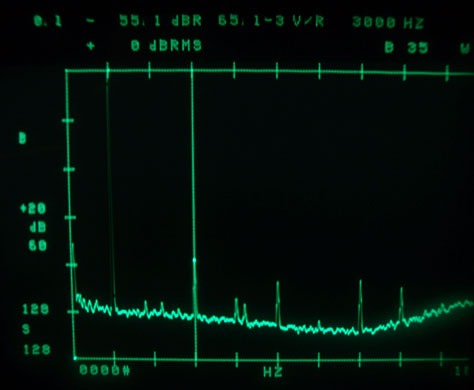
The K was just better...
And I also experienced the same thing with crowns and double crowns.
This discussion leads to nothing, I did chip testing for years and I stopped because I have my chips and I don't expect it gets any better
Best find the test signal that gives flawless results for your analyzer, obtain a lot of chips to compare and you will see for yourself.
K:

K2:

other K2:

The K was just better...
And I also experienced the same thing with crowns and double crowns.
This discussion leads to nothing, I did chip testing for years and I stopped because I have my chips and I don't expect it gets any better
Best find the test signal that gives flawless results for your analyzer, obtain a lot of chips to compare and you will see for yourself.
Bernhard,
Thanks for posting these figures. This is what I was getting at when I said we had no idea what the specs of the unlisted grades were. It's been a matter of faith that the order of listing in the datasheet denotes a progression in level of performance.
beauty_divine, is it possible to do a test at both 1khz and 991hz on the PCM63 grades you have? The 1khz test will at least be somewhat comparable to Bernhard's existing test results.
cheers
Paul
Thanks for posting these figures. This is what I was getting at when I said we had no idea what the specs of the unlisted grades were. It's been a matter of faith that the order of listing in the datasheet denotes a progression in level of performance.
beauty_divine, is it possible to do a test at both 1khz and 991hz on the PCM63 grades you have? The 1khz test will at least be somewhat comparable to Bernhard's existing test results.
cheers
Paul
I did this test with 1kHz already to see lots of spurs products in frequency domain, far from the product (PCM63) spec. Changing to 991 Hz, as BB stated as a test condition, I see distortion products rising above the noise floor (-120dB for my analyser) starting from -70dB fundamental tone and below. 1st harmonic for -70dB funadamental is around -116dB. For -60dB fundamental 1st harmonic is really unameasurable with the equipment I have, and in the entire spectrum there is nothing like lots of high order products as on Bernhard's spectrum.spzzzzkt said:beauty_divine, is it possible to do a test at both 1khz and 991hz on the PCM63 grades you have? The 1khz test will at least be somewhat comparable to Bernhard's existing test results.
beauty_divine said:
1st harmonic for -70dB funadamental is around -116dB. For -60dB fundamental 1st harmonic is really unameasurable with the equipment I have, and in the entire spectrum there is nothing like lots of high order products as on Bernhard's spectrum.
We should talk the same language.
Assuming you use the absolute log scale, the -70 dB input signal is shown as -70 dB on your analyzer, K2 is -116 dB.
I use the relative log scale, the -70 dB will is set as the 0 dB reference and the K2 is -46 dB.
-46 dB is really what I would expect from PCM63 for -70 dB signal.
Do you use averaging ???
IY,
I emailed that address on 24 Feb 2008 asking for pricing on the pcm63p-y - never got a response. This is why I said "can't be contacted". Trust me, I don't let a broken web enquiry form get in the way of tracking down things Did you get a reply from them?
Did you get a reply from them?
BTW I now have a full complement of pcm63p-y in my D1V3 and it's sounding pretty nice. I'm not in a position to a/b against other know good pcm63 but to be honest if this thread hadn't sown the seeds of doubt I probably would have been quite pleased with the chips. They are a significant improvement over the pcm63k I previously had in the DAC and I'll certainly be leaving them in place.
I think it's time to listen to Miles Davis' "Ghetto Walk" (from Complete "In A Silent Way" Sessions)
cheers
Paul
I emailed that address on 24 Feb 2008 asking for pricing on the pcm63p-y - never got a response. This is why I said "can't be contacted". Trust me, I don't let a broken web enquiry form get in the way of tracking down things
BTW I now have a full complement of pcm63p-y in my D1V3 and it's sounding pretty nice. I'm not in a position to a/b against other know good pcm63 but to be honest if this thread hadn't sown the seeds of doubt I probably would have been quite pleased with the chips. They are a significant improvement over the pcm63k I previously had in the DAC and I'll certainly be leaving them in place.
I think it's time to listen to Miles Davis' "Ghetto Walk" (from Complete "In A Silent Way" Sessions)
cheers
Paul
I use a hp 3580A spectrum analyzer to have this waveform on a KY chip. I think the 3580A use peak detector for the signal and this is an analogy spectrum and scanning takes a long time!
Test conditions:
Input SPDIR signal at -80dbfs, 1kHz signal
0db of spectrum scale is equale to -70dbm 600ohm
Total Span of specturm is 10khz or 1khz/div, vertical is 10db/div
The first tallest line from left is 1khz, and I can see 3rd, 5th, 7th harmonics.
The harmonics is about -105dbm max.
The IV is a common base jfet IV not a op-amp type.
I do not know why there are so many others harmonics around the 3rd, 5th, 7th harmonics. Is it due to the digital filter SM5842?
Please comment.
Test conditions:
Input SPDIR signal at -80dbfs, 1kHz signal
0db of spectrum scale is equale to -70dbm 600ohm
Total Span of specturm is 10khz or 1khz/div, vertical is 10db/div
The first tallest line from left is 1khz, and I can see 3rd, 5th, 7th harmonics.
The harmonics is about -105dbm max.
The IV is a common base jfet IV not a op-amp type.
I do not know why there are so many others harmonics around the 3rd, 5th, 7th harmonics. Is it due to the digital filter SM5842?
Please comment.
Attachments
spencer said:I use a hp 3580A spectrum analyzer to have this waveform on a KY chip. I think the 3580A use peak detector for the signal and this is an analogy spectrum and scanning takes a long time!
Test conditions:
Input SPDIR signal at -80dbfs, 1kHz signal
0db of spectrum scale is equale to -70dbm 600ohm
Total Span of specturm is 10khz or 1khz/div, vertical is 10db/div
The first tallest line from left is 1khz, and I can see 3rd, 5th, 7th harmonics.
The harmonics is about -105dbm max.
The IV is a common base jfet IV not a op-amp type.
I do not know why there are so many others harmonics around the 3rd, 5th, 7th harmonics. Is it due to the digital filter SM5842?
Please comment.
When I use the absolute scale like all of you, my PCM56 has worst harmonic -125 dB when tested with 1kHz -60dB signal
The artefacts around your harmonics could come from a weak laser and disc reading problems, when playing CDR.
Looks like signal correlated noise. Listen to the signal.
Do you have other grades of PCM63 like J/K/K2 to compare ?
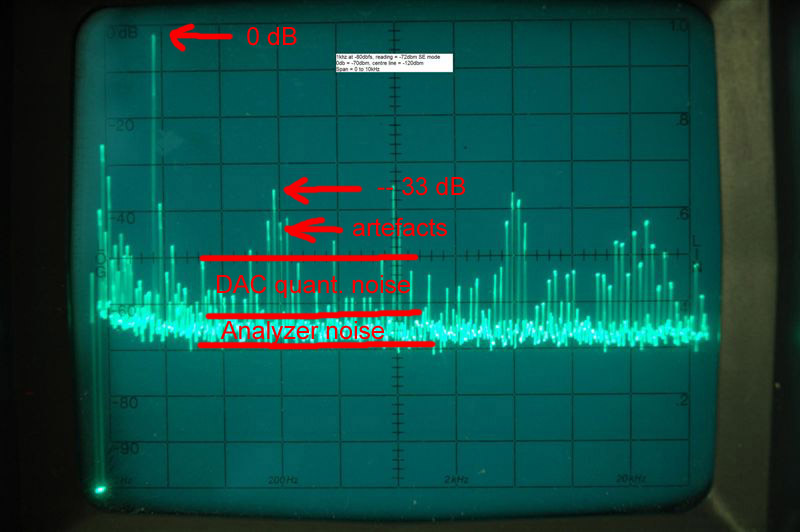
A long letter from a non technician...
Paul, I find your work to be extremely important; the things you already found - like this new evidence that the KY is an original BB product (good to know...) as all other info, are truly fabulous!!
Also good to know that we can leave out the topic of fakes Chips and go forward to examine what is the secret behind the sound and performances of the BB PCM 63’s.
Moreover: I am very appreciative to our colleagues Bernhard, Spencer, beauty_divine and others who are honestly trying to find out - what is the “electronically true” behind the 63's. It is extremely challanging topic and they desrve all support.
I am a conductor, not a technician. However, sound is a major topic for me after interpretation. Both belongs together: The listener should hear and feel the music. Simple to understand.
Among my very best friends and colleagues there are meny famous sound-engineers: Jimmy Lock, first sound engineer of "Decca" (we did 2 prize-winners CDs together, include the very first Decca's Optical-Disc Master-Recording in 1996), Stephan Reh, Christian Feldgen ("Schalloran"), Morten Winding, to name a few.
I dare to talk about sound.
Am happy to read that your D1V3 has now all 4x "Y" working; the significant improvement over the pcm63k is not of a surprise to me; I became convinced that there is something with this “Y” the moment I heard it. Discoveries should be shared with others. It is this kind of PCM that give a feeling of complete listening experience.
There are many interesting subjects coming across through Bernhard's courageous confrontation with finding the right relations between Sound and Measurements; will need a lot of time to confront myself with the questions and try answering them. Later may be.
It is not only my own expriance which shows that it is much a matter of learning process, and that even the perception of sound is being altered with time & experiance. Let’s take very experienced sound engineers: They might well agree on the best sound tracks (!) once they all hear them objectively. It is very possible to agree about sound: If you as a recording artist and your engineer can’t be in agreement about the sound – there is no recording session possible. Point.
Important example: Most of the artists and engineers will quite immediately agree about Hall-Acoustics. The problem for the engineer is therefore not “what is good or bad” about sound, but - how to pick up this natural sound & vibrations from the scene/venue. It is the different imagination & experience of the different engineers that will results in choosing different Hardware, different microphone-positioning , etc. This (and a quite long process) will results with having the finalized recorded sound/version we hear at home.
If human beings do have different sound perceptions, it is not “a priory”. It is a matter of the personal development-stage and experience.
Back to our HiFi: A clean sounding PCM might not give the all answers, while a TDA1541 silver crown or gold might be too dirty sounding, still appealing. However, appealing is not enough of course. Might be fake as well.
Untill the Y arrived, I was enjoying the more "brainy" listening to the indeed very clean “K”. But, I also knew and "sensed" that this “Clean” sound is not the all “true”. I was always asking myself what was quite sadly still missing.
It would be interesting to know, why the professionals does use “K2” or “Y”, but not the "J" or "K". I would say that they “know” something that this forum somehow has not revealed yet. There is some true behind.
The professional engineers “sense” somehow, that a complete sound should contain the complete dynamic range, the fullness of sound, with all lows and all highs, with the vibrations, the transparency... simply everything. Do we sense this at home or we are simply happy with our safe-by-us-made-world?
I wonder what will we have to do, if the Analyzer will show us -
that the K2, KY and Y are having certain dominant harmonics??
that they are “dirty” sounding??
that they have better/worth dynamic range??
that they are having better/worth distortion?
Is it a faith that BB put the PCMs in
P,
J,
K (1),
K2,
KY - and
Y ???
Is it a faith that the last 3 in the list were not advertised to the consumer market, but sold only to Professionals?
We might know more about this soon.
During the years I heard unbelievable wired HiFi systems by different people. They are not looking for the true but for what make them feel good, like life is for many of us (I assume).
Many HiFi enthusiastic are saying anyhow, that the recording Studio sounds like a S---T, so better I'll stop soon....
How many of us realy want to know the true?
p.s. Am listening now to MURRAY PERAHIA plays BACH, Partitas 2,3 & 4, a new SONY release. Pure music.
Greetings, IY.
Paul, I find your work to be extremely important; the things you already found - like this new evidence that the KY is an original BB product (good to know...) as all other info, are truly fabulous!!
Also good to know that we can leave out the topic of fakes Chips and go forward to examine what is the secret behind the sound and performances of the BB PCM 63’s.
Moreover: I am very appreciative to our colleagues Bernhard, Spencer, beauty_divine and others who are honestly trying to find out - what is the “electronically true” behind the 63's. It is extremely challanging topic and they desrve all support.
I am a conductor, not a technician. However, sound is a major topic for me after interpretation. Both belongs together: The listener should hear and feel the music. Simple to understand.
Among my very best friends and colleagues there are meny famous sound-engineers: Jimmy Lock, first sound engineer of "Decca" (we did 2 prize-winners CDs together, include the very first Decca's Optical-Disc Master-Recording in 1996), Stephan Reh, Christian Feldgen ("Schalloran"), Morten Winding, to name a few.
I dare to talk about sound.
Am happy to read that your D1V3 has now all 4x "Y" working; the significant improvement over the pcm63k is not of a surprise to me; I became convinced that there is something with this “Y” the moment I heard it. Discoveries should be shared with others. It is this kind of PCM that give a feeling of complete listening experience.
There are many interesting subjects coming across through Bernhard's courageous confrontation with finding the right relations between Sound and Measurements; will need a lot of time to confront myself with the questions and try answering them. Later may be.
It is not only my own expriance which shows that it is much a matter of learning process, and that even the perception of sound is being altered with time & experiance. Let’s take very experienced sound engineers: They might well agree on the best sound tracks (!) once they all hear them objectively. It is very possible to agree about sound: If you as a recording artist and your engineer can’t be in agreement about the sound – there is no recording session possible. Point.
Important example: Most of the artists and engineers will quite immediately agree about Hall-Acoustics. The problem for the engineer is therefore not “what is good or bad” about sound, but - how to pick up this natural sound & vibrations from the scene/venue. It is the different imagination & experience of the different engineers that will results in choosing different Hardware, different microphone-positioning , etc. This (and a quite long process) will results with having the finalized recorded sound/version we hear at home.
If human beings do have different sound perceptions, it is not “a priory”. It is a matter of the personal development-stage and experience.
Back to our HiFi: A clean sounding PCM might not give the all answers, while a TDA1541 silver crown or gold might be too dirty sounding, still appealing. However, appealing is not enough of course. Might be fake as well.
Untill the Y arrived, I was enjoying the more "brainy" listening to the indeed very clean “K”. But, I also knew and "sensed" that this “Clean” sound is not the all “true”. I was always asking myself what was quite sadly still missing.
It would be interesting to know, why the professionals does use “K2” or “Y”, but not the "J" or "K". I would say that they “know” something that this forum somehow has not revealed yet. There is some true behind.
The professional engineers “sense” somehow, that a complete sound should contain the complete dynamic range, the fullness of sound, with all lows and all highs, with the vibrations, the transparency... simply everything. Do we sense this at home or we are simply happy with our safe-by-us-made-world?
I wonder what will we have to do, if the Analyzer will show us -
that the K2, KY and Y are having certain dominant harmonics??
that they are “dirty” sounding??
that they have better/worth dynamic range??
that they are having better/worth distortion?
Is it a faith that BB put the PCMs in
P,
J,
K (1),
K2,
KY - and
Y ???
Is it a faith that the last 3 in the list were not advertised to the consumer market, but sold only to Professionals?
We might know more about this soon.
During the years I heard unbelievable wired HiFi systems by different people. They are not looking for the true but for what make them feel good, like life is for many of us (I assume).
Many HiFi enthusiastic are saying anyhow, that the recording Studio sounds like a S---T, so better I'll stop soon....
How many of us realy want to know the true?
p.s. Am listening now to MURRAY PERAHIA plays BACH, Partitas 2,3 & 4, a new SONY release. Pure music.
Greetings, IY.
- Status
- This old topic is closed. If you want to reopen this topic, contact a moderator using the "Report Post" button.
- Home
- Source & Line
- Digital Line Level
- Real or fake PCM63?
